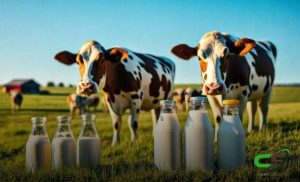Key points:
Some in the dairy industry say the reintroduction of a school milk program would help children’s nutrition
The free national school milk program ran from the 1950s to the 1970s
One dairy farmer says the reintroduction would also help support the dairy industry
Now Australia’s dairy industry wants to bring the program back into schools to help address a significant shortfall in the dairy intake of school-aged children.
According to Dairy Australia, children need on average three serves of dairy a day but four out of five are missing out on the daily recommendation.
A national milky way
The free school milk program was first introduced by the Menzies Government in 1951.
Called the Milk for School Children program, it was adopted in all Australian states — with the exception of Queensland, which raised concerns about its tropical climate and huge distances between centres.
An agreement saw the scheme operating in the state from 1953.
The Coombs Report, released in the early 1970s, determined continuation of the free milk scheme could not be justified on nutritional grounds.
After a cost blowout, the federal program was ended by then prime minister Gough Whitlam in 1973.
Various states implemented versions of the milk in schools program until as late as the mid 1980s.
Milk monitors, tepid temperatures and simpler times
Dairy farmer Michele Hamilton runs a dairy at OB Flat with her husband, Graeme, and son, Craig, in south-east South Australia.
The Hamilton’s Run farm breeds 540 replacement Australian Red heifers each year, producing around 4 million litres of milk annually.
“My memories of school milk stem from my time at Mount Gambier North Primary School in the 70s,” Ms Hamilton said.
“Nutrition was seen as important because generations prior — including the war and depression eras — had shown Australians what a lack of good nutrition meant.”
Ms Hamilton said her memories of the school milk program were mostly fond.
“I recall that each class would send two ‘milk monitors’ to collect a crate of small, glass milk bottles sealed with a foil cap,” she said.
“The monitors also had the job of inserting the paper drinking straws through the foil lid — I remember I always wanted to pierce the lid because it made such a pleasing sound.”
But not everyone who received milk as part of the daily school ritual had such fond memories.
“Plenty of people comment about the milk being warm at certain times of the year, but we are talking about a time when refrigeration wasn’t as plentiful and we didn’t know any different,” Ms Hamilton said.
“Having our daily milk was a shared classroom event in which almost every student took part — it was very much an accepted idea.”
Back to the future for school milk
“Logic would say that a school milk program would help the dairy industry while nurturing school-aged children,” Ms Hamilton said.
It is a sentiment echoed by New South Wales dairy lobby group Dairy Connect.
In 2018 the group, in partnership with Foodbank NSW and ACT, called on the NSW Government to fund free daily breakfasts, including freely available milk, for primary school students.
Dairy Connect CEO Shaughn Morgan said health benefits for generations of school children had been poorer since the abolishment of the federal school milk scheme.
“Since the 1980s, concern has grown year-on-year among health professionals about the impact carbonated soft drinks and energy drinks high in sugar were having on successive generations,” Mr Morgan said.
“All dairy milk whether it’s fat free, flavoured or organic provides nine essential nutrients … as well as other nutrients including B vitamins for energy, vitamin A to help maintain a healthy immune system, calcium and vitamin D.”
Ms Hamilton said introducing more milk into schools would benefit both children and the broader dairy industry, after the sector’s challenges in recent years.
“As a generalisation that would be great; any new movement would require some good planning on how to best integrate it,” she said.
“There are some efforts to provide milk into schools via the Foodbank Breakfast program, which has been supported by milk processors and dairy farmers … while recognising that there is work to do with logistics, shelf life, and storage at schools.
“To grow long-term demand for dairy products though, it’s more important that families understand the need to have dairy on the table and incorporate it into their daily meals and snacks.”












